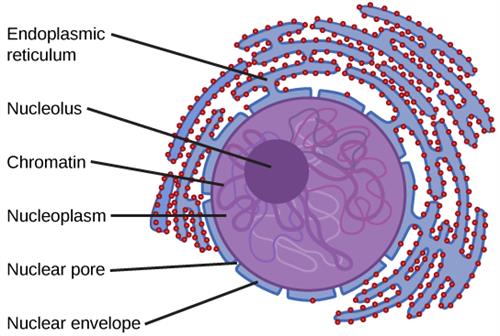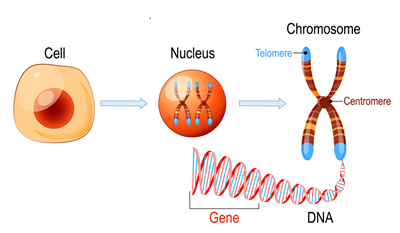PDF chapter test TRY NOW
Similar to the brain, which controls all the functioning of our body, in the cell, there is a controlling centre which controls the functioning of the cell called Nucleus.
Robert Brown discovered the nucleus in \(1831\) and is the controlling centre of all the activities. Hence it is described as the brain of the cell. It is composed of double-layered covering called nuclear membrane. It has numerous pores called nuclear pores. They transfer the material from inside the nucleus to cytoplasm.

Picture showing the components of the nucleus
The nucleus contains Chromosomes. If they are visible as rod-shaped structures, cell division will occur. It encompass a liquid ground substance called Nucleoplasm. It contains nucleolus and chromatin material.
Nucleolus is almost like a round structure which is found inside the nucleus. There is no covering membrane for it, and acts as a site for synthesis of ribosomes. Hence it is termed as factory of ribosomes.
Chromatin is a bunch of long thread-like structures found inside the Nucleus. It is composed of DNA and proteins that condense to form chromosomes. Whenever the cell involves in cell division, the chromatin material gets organized into chromosomes.
Chromosomes contain information which inherits characters from parents to the next generation through DNA (Deoxyribonucleic acid). Genes are known to be the functional segment of DNA. There are two significant constituents present inside the chromosomes, i.e., DNA and protein. The DNA molecules possess enough information for constructing and organizing the cells. Nucleus also contains RNA (Ribonucleic acid) which directs the synthesis of protein molecule.

Picture showing the location of the gene inside a cell
In few organisms like bacteria, cell's nuclear region is not fully developed due to the absence of double-layered covering membrane. In those cases, only nucleic acid is present in the nuclear region. Such an undefined nuclear region is called nucleoid.
Functions of the Nucleus:
1. Nucleus is the chief controller of a cell. It contains chromosomes which carry genes. Genes are responsible for the transmission of hereditary characters from parents to offspring.
2. Nucleus with RNAs help directs the synthesis of structural proteins and other chemical needed for cell growth and cell maintenance.
3. All the metabolic activities of the cell is controlled by the nucleus.
4. It plays a key role in cellular reproduction, a process that involves cell division and produces genetically identical daughter cell by a process known as mitosis.
- Nucleus is the largest cell organelle.
- Nucleus is absent in Mature sieve cells of vascular plants.
- Red blood cells of mammals have a nucleus during the early stages of their development, and later it will disappear. So, mature \(RBC\) do not have nucleus.
- Nucleus is a storehouse of hereditary information.
Important!
Reference:
https://commons.wikimedia.org/wiki/File:0318_Nucleus.jpg
